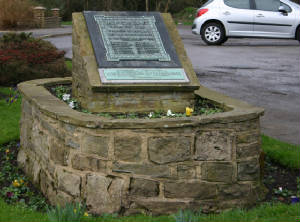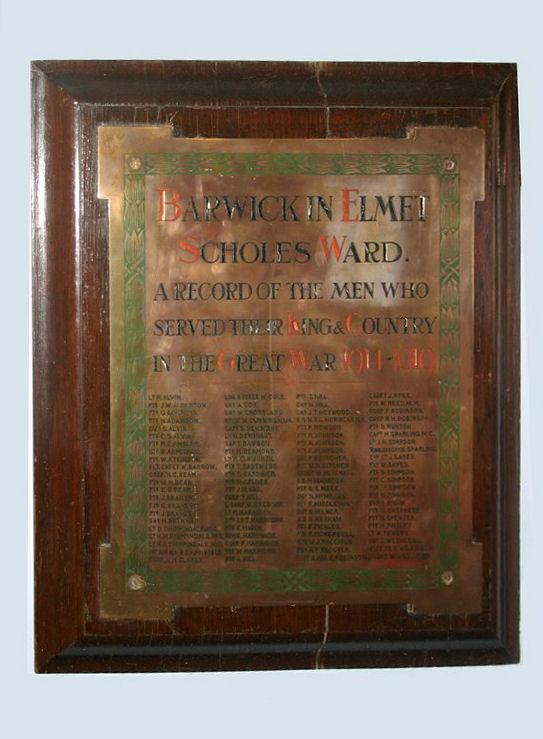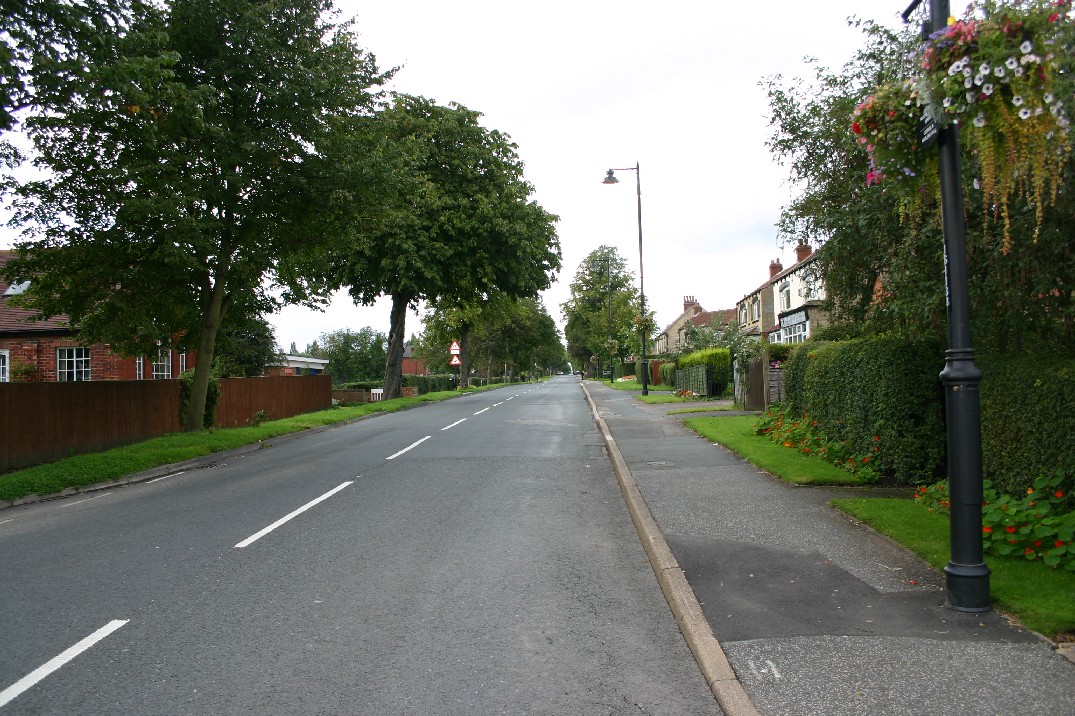The War Memorials at Scholes
The War Memorials at Scholes
Secondly, along the length of Station Road there is an avenue of Horse Chestnut and Lime trees, each of which was planted to commemorate one of the fallen of Scholes. If one stands by the War Memorial facing towards the A64 York Road, the trees on the left (school) side of the road were planted to honour the dead of the Great War, while those on the right (shops) side were planted in memory of those who lost their lives in the Second World War.
Lastly there is a Roll of Honour which lists the names of all the men from Scholes who served during the Great War. This last memorial is in the form of a plaque and is wall mounted in the Manor House on Belle Vue Road. The Manor House is the community centre for the sheltered housing complex in the village which was built on the site of the former Scholes Hall, and the land belonging to it (see the Alvin Brothers)
The three memorials in Scholes are listed on the United Kingdom National Inventory of War Memorials (UKNIWM) database their references are below:
The main War Memorial: - 58310
The Manor House Roll of Service: - 58309
The Avenue of Memorial Trees: - 58308
The plaque commemorating those who died in the Great War was designed by William Caldwell Spruce, the head modeller and sculptor at the Leeds Fireclay Company Ltd, perhaps better known as 'Burmantofts Pottery'.
Originally the plaque which forms the War Memorial and the plaque carrying the Roll of Service were located at the former Parish Council office building on Station Road. The War Memorial plaque was wall mounted underneath the clock, facing the road and the Roll of Honour was housed inside the council chamber.
The following account was written by Mr Alan Senior and is taken from "The Barwicker", the journal of the Barwick Historical Society, and I am grateful to the society and in particular the former editor, Mr Arthur Bantoft, for permission to use it here.
"In April 1919, it was reported that the Scholes War Memorial Committee was desirous of commemorating those who had fallen in the War and those who had served in HM Forces during the War, by placing a clock at the Council Offices.
The Parish Council agreed that the Committee be given permission to erect a clock on the building at Scholes and that they also be allowed to place a tablet, or tablets, in the Council Room with all the names of the men who had served in HM Forces "fighting during the War", from the Parish of Barwick-in-Elmet. The tablet is now displayed in the Manor House in Scholes.
In October 1920 it was reported that the Parish Council had received a letter from Miss Cox, Secretary of the Scholes War Memorial Committee, stating that her Committee had unanimously resolved to hand over the clock, roll of honour and tablets erected by public subscription of the inhabitants of Scholes to be held in perpetuity. This was agreed.
In August 1932, the Parish Council received a deputation from Mr Blackie and Mr Gosnay regarding the condition of the War Memorial. It was agreed to provide posts and chains and renovation of the tablet.
It was noted that, under the War Memorials Act of 1923, the Council could "claim back" any cost of improvements not exceeding £15.
In October 1932, the Parish Council approved the undermentioned expenditure:
1. New gate and fence.
2. Painting gate and fence.
3. Renovating tablet.
4. Adjacent tarmacadam paving and kerbing.
The total cost was £14. 2s. 0d"
In 1951, as part of the Festival of Britain, the Scholes Scout and Girl Guides groups laid out a festival garden at the point where Main Street meets Station Road, and the War Memorial plaque now forms the focal point of this garden. The new memorial is mounted on an angled plinth which is surrounded by a raised flower bed, and thanks to the "Scholes in Bloom" group the whole garden is very well kept and provides a pleasing sight all year round. The plaques detailing the fallen of both wars are cast in bronze of differing alloys.
In recent years, the Parish Council office building has been sold and is now a private dwelling. This move from public to private ownership made it necessary to move the Roll of Honour to a new location and the Scholes Manor House was considered to be the right location for it. It is now wall mounted in the main room of the Manor House in a prominent position. The plaque is made in brass and the wording is engraved and inlaid with pigment to provide contrast.
The War Dead from the period of 1939 - 1945 are only commemorated on the main War Memorial, and one side of the avenue of trees the remaining memorial, that at the Manor House, being dedicated only to those men who saw service during the Great War.
The plaque commemorating the fallen from the Second World War was unveiled at a special ceremony on Sunday, 24 July 1949. The Rector, Reverend Canon Gray MA conducted the service, and the plaque was unveiled by Mr W. Senior in his capacity as Chairman of the Barwick in Elmet and Scholes British Legion. The ceremony must have been a particularly poignant one for Rev Canon Gray. His own son, Maurice Richard Worrall Gray, a 23-year-old Lieutenant with 6th Green Howards had been killed in North Africa in 1942 and lies buried in El Alamein War Cemetery in Egypt.


